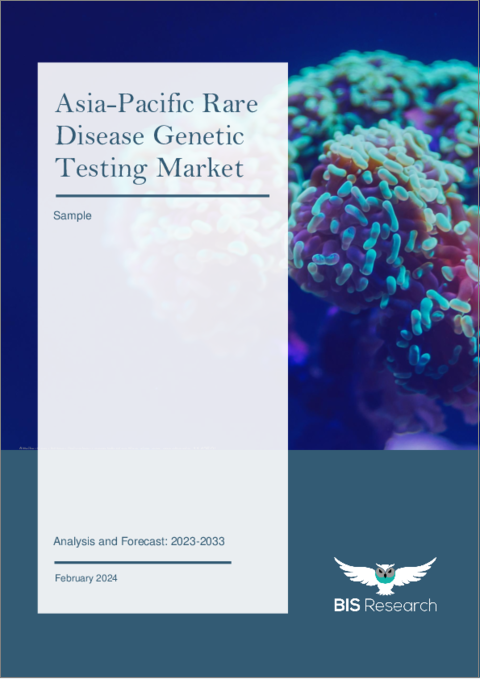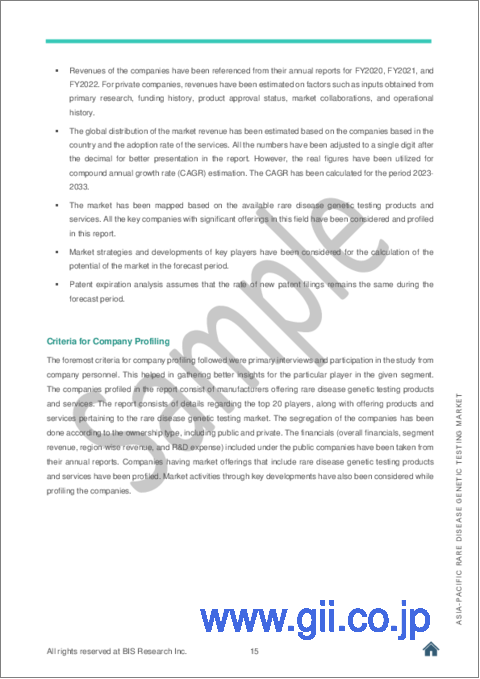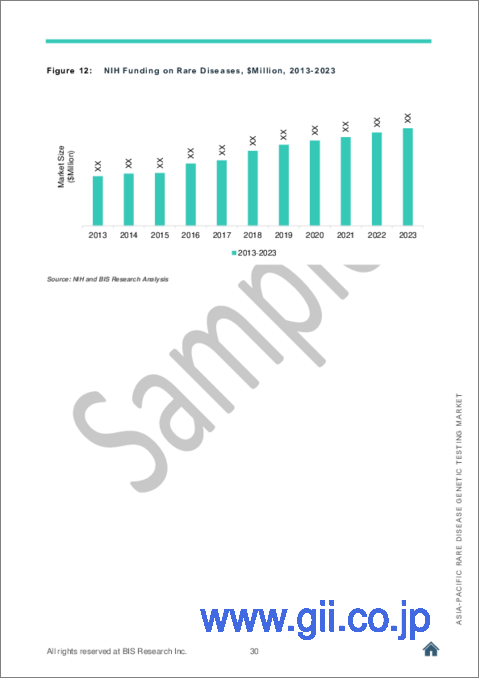|
|
市場調査レポート
商品コード
1439025
アジア太平洋の希少疾患遺伝子検査市場:分析と予測(2023年~2033年)Asia-Pacific Rare Disease Genetic Testing Market: Analysis and Forecast, 2023-2033 |
||||||
カスタマイズ可能
|
|||||||
| アジア太平洋の希少疾患遺伝子検査市場:分析と予測(2023年~2033年) |
|
出版日: 2024年02月29日
発行: BIS Research
ページ情報: 英文 104 Pages
納期: 1~5営業日
|
全表示
- 概要
- 図表
- 目次
| 主要市場統計 | |
|---|---|
| 予測期間 | 2023年~2033年 |
| 2023年の評価 | 5億8,000万米ドル |
| 2033年予測 | 24億米ドル |
| CAGR | 15.25% |
アジア太平洋の希少疾患遺伝子検査市場は、2023年に5億8,000万米ドルとなりました。
同市場は、2033年には24億米ドルに達すると予測され、予測期間の2023年~2033年のCAGRは15.25%になると予測されています。全ゲノムシーケンシング(WGS)や全エクソームシーケンシング(WES)のような先進技術は、それぞれ個人の全遺伝コード(ゲノム)または特定のタンパク質コード領域(エクソーム)を解析します。これらの技術は、希少疾患に関連する遺伝的変異、突然変異、異常の検出に役立ちます。
アジア太平洋の希少疾患遺伝子検査市場は、様々な要因によって著しい成長を遂げています。認知度の向上、遺伝子検査技術の進歩、医療費の増加が市場拡大に寄与しています。さらに、この地域の人口の多さと多様な遺伝子プロファイルは、遺伝子検査プロバイダーに大きな機会をもたらしています。ヘルスケアインフラの改善と遺伝子検査サービスへのアクセス拡大を目指す政府の取り組みは、市場成長をさらに促進します。さらに、ヘルスケア機関、研究機関、業界関係者の協力により、この地域特有のニーズに合わせた革新的な遺伝子検査ソリューションの開発と導入が促進されています。精密医療と個別化ヘルスケアへの注目が高まる中、APACの希少疾患遺伝子検査市場は、当面、継続的な拡大と革新が見込まれます。
当レポートでは、アジア太平洋の希少疾患遺伝子検査市場について調査し、市場の概要とともに、疾患タイプ別、技術別、国別の動向、および市場に参入する企業のプロファイルなどを提供しています。
目次
エグゼクティブサマリー
第1章 市場
- 市場の見通し
- 業界分析
- 市場力学
- 概要
- 市場の促進要因
- 市場の課題
- 市場の機会
第2章 希少疾患遺伝子検査市場(地域別)
- アジア太平洋の希少疾患遺伝子検査市場
- 市場力学
- 市場規模と予測
第3章 企業プロファイル
List of Figures
- Figure 1: Prevalence Rare Disease, 2022
- Figure 2: Asia-Pacific Rare Disease Genetic Testing Market, $Billion, 2022-2033
- Figure 3: Rare Disease Genetic Testing Market, Market Dynamics
- Figure 4: Most Frequently Studied Rare Diseases, 2021
- Figure 5: Asia-Pacific Rare Disease Genetic Testing Market Share (by Technology), 2022 and 2033
- Figure 6: Asia-Pacific Rare Disease Genetic Testing Market Share (by Disease Type), 2022 and 2033
- Figure 7: Share of Key Developments and Strategies, January 2019-June 2023
- Figure 8: Rare Disease Genetic Testing Market: Research Methodology
- Figure 9: Primary Research Methodology
- Figure 10: Bottom-Up Approach (Segment-Wise Analysis)
- Figure 11: Top-Down Approach (Segment-Wise Analysis)
- Figure 12: Asia-Pacific Rare Disease Genetic Testing Market Potential, $Billion, 2022-2033
- Figure 13: Rare Disease Genetic Testing Market, Patent Analysis (by Country), January 2018- June 2023
- Figure 14: Rare Disease Genetic Testing Market, Patent Analysis (by Year), January 2018-June 2023
- Figure 15: NIH Funding on Rare Diseases, $Million, 2013-2023
- Figure 16: Rare Disease Genetic Testing Market Dynamics
- Figure 17: Rare Disease Prevalence in India, 2022
- Figure 18: Prevalence of Rare Diseases, 2022
- Figure 19: Most Frequently Studied Rare Diseases, 2021
- Figure 20: Publications Related to the Use of Artificial Intelligence for Rare Disease Diagnosis, 2015-2022
- Figure 21: Rare Disease Genetic Testing Market Share (by Region), 2022-2033
- Figure 22: Asia-Pacific Rare Disease Genetic Testing Market, $Billion, 2022-2033
- Figure 23: Asia-Pacific Rare Disease Genetic Testing Market (by Disease Type), $Million, 2022-2033
- Figure 24: Asia-Pacific Rare Disease Genetic Testing Market (by Technology), $Million, 2022-2033
- Figure 25: Asia-Pacific Rare Disease Genetic Testing Market (by Country), % Share, 2022 and 2033
- Figure 26: Japan Rare Disease Genetic Testing Market, $Million, 2022-2033
- Figure 27: Japan Rare Disease Genetic Testing Market (by Disease Type), $Million, 2022-2033
- Figure 28: Japan Rare Disease Genetic Testing Market (by Technology), $Million, 2022-2033
- Figure 29: China Rare Disease Genetic Testing Market, $Million, 2022-2033
- Figure 30: China Rare Disease Genetic Testing Market (by Disease Type), $Million, 2022-2033
- Figure 31: China Rare Disease Genetic Testing Market (by Technology), $Million, 2022-2033
- Figure 32: Australia Rare Disease Genetic Testing Market, $Million, 2022-2033
- Figure 33: Australia Rare Disease Genetic Testing Market (by Disease Type), $Million, 2022-2033
- Figure 34: Australia Rare Disease Genetic Testing Market (by Technology), $Million, 2022-2033
- Figure 35: South Korea Rare Disease Genetic Testing Market, $Million, 2022-2033
- Figure 36: South Korea Rare Disease Genetic Testing Market (by Disease Type), $Million, 2022-2033
- Figure 37: South Korea Rare Disease Genetic Testing Market (by Technology), $Million, 2022-2033
- Figure 38: India Rare Disease Genetic Testing Market, $Million, 2022-2033
- Figure 39: India Rare Disease Genetic Testing Market (by Disease Type), $Million, 2022-2033
- Figure 40: India Rare Disease Genetic Testing Market (by Technology), $Million, 2022-2033
- Figure 41: Singapore Rare Disease Genetic Testing Market, $Million, 2022-2033
- Figure 42: Singapore Rare Disease Genetic Testing Market (by Disease Type), $Million, 2022-2033
- Figure 43: Singapore Rare Disease Genetic Testing Market (by Technology), $Million, 2022-2033
- Figure 44: Rest-of-Asia-Pacific Rare Disease Genetic Testing Market, $Million, 2022-2033
- Figure 45: Rest-of-Asia-Pacific Rare Disease Genetic Testing Market (by Disease Type), $Million, 2022-2033
- Figure 46: Rest-of-Asia-Pacific Rare Disease Genetic Testing Market (by Technology), $Million, 2022-2033
- Figure 47: Rare Disease Genetic Testing Market, Total Number of Key Companies Profiled
- Figure 48: 3billion, Inc: Product Portfolio
- Figure 49: Konica Minolta (Ambry Genetics, Inc.): Product Portfolio
- Figure 50: Konica Minolta (Ambry Genetics, Inc.).: Overall Financials, $Million, 2020-2022
- Figure 51: Konica Minolta (Ambry Genetics, Inc.): Net Revenue (by Segment), $Million, 2020-2022
- Figure 52: Konica Minolta (Ambry Genetics, Inc.): Net Revenue (by Region), $Million, 2020-2022
- Figure 53: Konica Minolta (Ambry Genetics, Inc.): R&D Expenditure, $Million, 2020-2022
- Figure 54: BGI Genomics: Product Portfolio
- Figure 55: BGI Genomics.: Overall Financials, $Million, 2020-2022
- Figure 56: Strand Life Science Pvt Ltd.: Product Portfolio
List of Tables
- Table 1: Key Questions Answered in the Report
- Table 2: Funding for Rare Disease Research
- Table 3: Technological Advancements in the Rare Disease Genetic Testing Ecosystem
- Table 4: Expansion of Medicare Coverage for Rare Disease Genetic Testing Tests (by Companies)
- Table 5: Asia-Pacific Rare Disease Genetic Testing Market, Impact Analysis
The Asia Pacific Rare Disease Genetic Testing Market Expected to Reach $2.40 Billion by 2033
Introduction to Asia-Pacific Rare Disease Genetic Testing Market
| KEY MARKET STATISTICS | |
|---|---|
| Forecast Period | 2023 - 2033 |
| 2023 Evaluation | $0.58 Billion |
| 2033 Forecast | $2.40 Billion |
| CAGR | 15.25% |
The Asia-Pacific rare disease genetic testing market was valued at $0.58 billion in 2023 and is anticipated to reach $2.40 billion by 2033, witnessing a CAGR of 15.25% during the forecast period 2023-2033. Advanced technologies like whole-genome sequencing (WGS) and whole-exome sequencing (WES) analyze an individual's entire genetic code (genome) or specific protein-coding regions (exome), respectively. They aid in detecting genetic variations, mutations, or abnormalities linked to rare diseases.
Market Introduction
The Asia-Pacific (APAC) rare disease genetic testing market is witnessing notable growth driven by various factors. Increased awareness, advancements in genetic testing technologies, and rising healthcare expenditure contribute to market expansion. Moreover, the region's large population base and diverse genetic profiles present significant opportunities for genetic testing providers. Government initiatives aimed at improving healthcare infrastructure and expanding access to genetic testing services further propel market growth. Additionally, collaborations between healthcare organizations, research institutions, and industry players facilitate the development and adoption of innovative genetic testing solutions tailored to the region's specific needs. With a growing focus on precision medicine and personalized healthcare, the APAC rare disease genetic testing market is poised for continued expansion and innovation in the foreseeable future.
Market Segmentation:
Segmentation 1: by Disease Type
- Gastroenterology Disease
- Endocrine and Metabolism Disease
- Cardiovascular Disease
- Neurology Disease
- Hematology and Oncology Disease
- Dermatology Disease
- Other Diseases
Segmentation 2: by Technology
- Sanger Sequencing
- PCR
- NGS
- Microarrays
- Others (Targeted Cytogenetics, Karyotyping, and FISH)
Segmentation 3: by Country
- Japan
- India
- China
- South Korea
- Australia
- Singapore
- Rest-of-Asia-Pacific
How Can This Report Add Value to an Organization?
Product/Innovation Strategy: The APAC rare disease genetic testing market has been extensively segmented based on various categories, such as disease type, technology, and country. This can help readers understand which segments account for the largest share and which are well-positioned to grow in the coming years.
Competitive Strategy: The APAC rare disease genetic testing market has numerous established players paving their way into providing tests, panels, and assays in the market. Key players in the global rare disease genetic testing market analyzed and profiled in the study involve established players offering various disease-specific panels and multiplex instruments.
Key Market Players and Competition Synopsis
The companies that are profiled have been selected based on inputs gathered from primary experts and analysing the company's coverage, product portfolio, its market penetration.
Some of the prominent names established in this market are:
- 3billion, Inc.
- Konica Minolta (Ambry Genetics, Inc.)
- BGI Group
- Strand Life Science Pvt Ltd.
Table of Contents
Executive Summary
Scope of the Study
Research Methodology
1 Market
- 1.1 Market Outlook
- 1.1.1 Product Definition
- 1.1.2 Inclusion and Exclusion Criteria
- 1.1.2.1 Inclusion Criteria
- 1.1.2.2 Exclusion Criteria
- 1.1.3 Market Overview
- 1.1.3.1 Market Footprint
- 1.1.3.2 Market Size and Future Growth Potential
- 1.1.4 COVID-19 Impact on the Market
- 1.1.4.1 Impact on Research and Clinical Operations
- 1.1.4.2 COVID-19 Impact: Current Scenario of the Market
- 1.2 Industry Analysis
- 1.2.1 Regulatory Framework
- 1.2.1.1 Legal Requirements and Framework in Asia-Pacific
- 1.2.1.1.1 Japan
- 1.2.1.1.2 China
- 1.2.1.1.3 India
- 1.2.1.1.4 Taiwan
- 1.2.1.1 Legal Requirements and Framework in Asia-Pacific
- 1.2.2 Patent Analysis
- 1.2.2.1 Patent Filing Trend (by Country)
- 1.2.2.2 Patent Filing Trend (by Year)
- 1.2.3 Funding Scenario
- 1.2.1 Regulatory Framework
- 1.3 Market Dynamics
- 1.3.1 Overview
- 1.3.2 Market Drivers
- 1.3.2.1 Rapid Technological Advancements in Rare Disease Diagnosis
- 1.3.2.2 Rising Prevalence of Genetic Disorders and Congenital Disorders
- 1.3.2.3 Growing Recognition and Emphasis on Early Detection and Prevention of Rare Diseases in Pediatric Populations
- 1.3.3 Market Challenges
- 1.3.3.1 Lack of Consolidation of Information Leading to Difficulty in Diagnosis
- 1.3.3.2 Significant Capital Requirement for Research and Development Hindering Global Expansion Efforts
- 1.3.4 Market Opportunities
- 1.3.4.1 Whole Genome Sequencing Putting an End to the Rare Disease Genetic Testing Odysseys
- 1.3.4.2 AI-Based Diagnostic Tools Diagnosing Rare Diseases by Identifying Potential Diagnoses
- 1.3.4.3 Transitioning toward Increased Genetics Coverage in Reimbursement Policies
2 Rare Disease Genetic Testing Market (by Region)
- 2.1 Asia-Pacific Rare Disease Genetic Testing Market
- 2.1.1 Market Dynamics
- 2.1.1.1 Impact Analysis
- 2.1.2 Market Size and Forecast
- 2.1.2.1 Asia-Pacific Rare Disease Genetic Testing Market (by Disease Type)
- 2.1.2.2 Asia-Pacific Rare Disease Genetic Testing Market (by Technology)
- 2.1.2.3 Asia-Pacific Rare Disease Genetic Testing Market (by Country)
- 2.1.2.3.1 Japan
- 2.1.2.3.1.1 Market Dynamics
- 2.1.2.3.1.2 Market Size and Forecast
- 2.1.2.3.1.2.1 Japan Rare Disease Genetic Testing Market (by Disease Type)
- 2.1.2.3.1.2.2 Japan Rare Disease Genetic Testing Market (by Technology)
- 2.1.2.3.2 China
- 2.1.2.3.2.1 Market Dynamics
- 2.1.2.3.2.2 Market Size and Forecast
- 2.1.2.3.2.2.1 China Rare Disease Genetic Testing Market (by Disease Type)
- 2.1.2.3.2.2.2 China Rare Disease Genetic Testing Market (by Technology)
- 2.1.2.3.3 Australia
- 2.1.2.3.3.1 Market Dynamics
- 2.1.2.3.3.2 Market Size and Forecast
- 2.1.2.3.3.2.1 Australia Rare Disease Genetic Testing Market (by Disease Type)
- 2.1.2.3.3.2.2 Australia Rare Disease Genetic Testing Market (by Technology)
- 2.1.2.3.4 South Korea
- 2.1.2.3.4.1 Market Dynamics
- 2.1.2.3.4.2 Market Size and Forecast
- 2.1.2.3.4.2.1 South Korea Rare Disease Genetic Testing Market (by Disease Type)
- 2.1.2.3.4.2.2 South Korea Rare Disease Genetic Testing Market (by Technology)
- 2.1.2.3.5 India
- 2.1.2.3.5.1 Market Dynamics
- 2.1.2.3.5.2 Market Size and Forecast
- 2.1.2.3.5.2.1 India Rare Disease Genetic Testing Market (by Disease Type)
- 2.1.2.3.5.2.2 India Rare Disease Genetic Testing Market (by Technology)
- 2.1.2.3.6 Singapore
- 2.1.2.3.6.1 Market Dynamics
- 2.1.2.3.6.2 Market Size and Forecast
- 2.1.2.3.6.2.1 Singapore Rare Disease Genetic Testing Market (by Disease Type)
- 2.1.2.3.6.2.2 Singapore Rare Disease Genetic Testing Market (by Technology)
- 2.1.2.3.7 Rest-of-Asia-Pacific
- 2.1.2.3.7.1 Market Dynamics
- 2.1.2.3.7.2 Market Size and Forecast
- 2.1.2.3.7.2.1 Rest-of-Asia-Pacific Rare Disease Genetic Testing Market (by Disease Type)
- 2.1.2.3.7.2.2 Rest-of-Asia-Pacific Rare Disease Genetic Testing Market (by Technology)
- 2.1.2.3.1 Japan
- 2.1.1 Market Dynamics
3 Company Profiles
- 3.1 Overview
- 3.1.1 3billion, Inc.
- 3.1.1.1 Company Overview
- 3.1.1.2 Role of 3billion, Inc. in the Rare Disease Genetic Testing Market
- 3.1.1.3 Recent Developments
- 3.1.1.4 Analyst Perspective
- 3.1.2 Konica Minolta (Ambry Genetics, Inc.)
- 3.1.2.1 Company Overview
- 3.1.2.2 Role of Konica Minolta (Ambry Genetics, Inc.) in the Rare Disease Genetic Testing Market
- 3.1.2.3 Financials
- 3.1.2.4 Recent Developments
- 3.1.2.5 Analyst Perspective
- 3.1.3 BGI Group
- 3.1.3.1 Company Overview
- 3.1.3.2 Role of BGI Group in the Rare Disease Genetic Testing Market
- 3.1.3.3 Financials
- 3.1.3.4 Recent Developments
- 3.1.3.5 Analyst Perspective
- 3.1.4 Strand Life Science Pvt Ltd.
- 3.1.4.1 Company Overview
- 3.1.4.2 Role of Strand Life Science Pvt Ltd. in the Rare Disease Genetic Testing Market
- 3.1.4.3 Recent Developments
- 3.1.4.4 Analyst Perspective
- 3.1.1 3billion, Inc.





